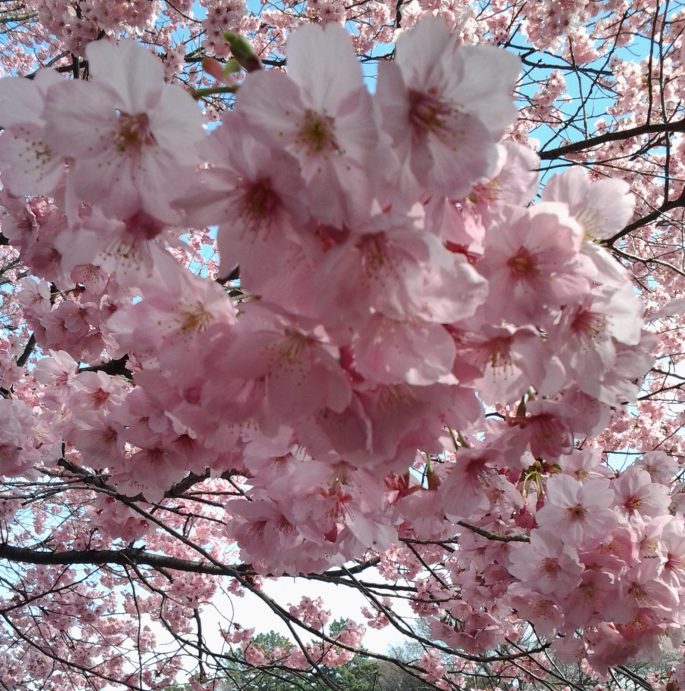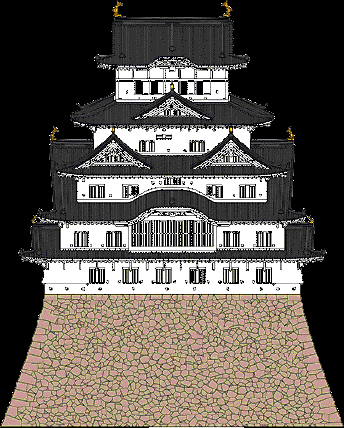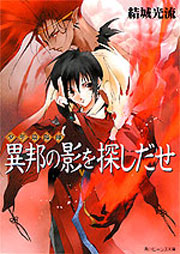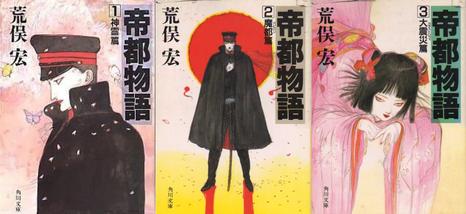
(For a limited time, my new novelette will be available one chapter published weekly.)
Forest Bathing
(Shinrin Yoku)
森林浴
Deep into the woods
where everything is silent,
peaceful, relaxing
Chapter One
Mountain Goblin
The spring morning calls
into the haunted forest
forgotten secrets.
–Ancient Scroll
Year of the Dragon–1484
Men had set a death kinjiru that forbade women to set foot on the sacred ground. Yet for the past eight years, Tomiko Hino crept in secret beneath the grandfather cryptomeria, the giant evergreens that covered the sloping sides of Mount Haguro.
Each spring, when the dance of the dawn goddess lured Amaterasu back from winter exile, Tomiko’s family made their pilgrimage to the smallest of the three Brother Mountains. It was Haguro where the shrine dedicated to the three gods of the mountains perched on its summit. This was the place and the time when Tomiko crept away from the other women and made her clandestine journey into the forest.
Through the dense branches that grew high above her head, shifting sunlight filtered down through the morning fog. She closed her eyes hoping to hear what the gods would tell her. All the times before, they spoke through whispers in the wind or through the chilled dampness that kissed her cheeks. But this morning they spoke through sharp, crisp snaps and pops in the crack of high branches. The sounds echoed against the whirring wing-beats of a crane in flight.
Elegant neck extended, the white bird, with black-tipped feathers, soared from the enclosure of trees toward the green canopy high above Tomiko’s head. The bird’s voice quavered like a haunting trumpet of protest. But at what was it complaining?
Near the tree where the crane took flight, Tomiko spied a Raven perched on a lower branch. Its ebony feathers glistened like emeralds in the early morning light, as if jewels shined beneath the dark pinions.
Tomiko smiled, pretending the sassy black bird could actually understand her words. She said, “Did you frighten the crane?”
Head cocked to one side, the Raven waited. Its shrewd eyes seemed to watch her. The next instant, the brute flew at her face. The tip end of one wing flicked her nose as it soared by, sending a shock wave of astonishment that rolled down her spine to quake in the pit of her stomach.
She threw up her hands, beating wildly at the Raven’s sharp beak that snapped close to her ear. Then in a swooping motion, the black bird doubled back, diving straight for her again, but this time, it grabbed onto the narrow slope of her shoulder.
Startled more than frightened, Tomiko shrank away. Fingers splayed, she shoved at the beast’s clinging claws, while the peppery scent of pine needles filled her mouth and nose, irritating her eyes.
When the Raven refused to budge, Tomiko trembled with expectation. Breath held, she waited for its sharp talons to rip into her flesh.
Her words wrapped around a suppressed scream that scraped its way up her throat. “Wha-what, who, who are you?”
Her voice squeaked. Are you an emissary to the gods?”
The Raven leaned its head close to her face as if to stare directly into her soul. Its almond-shaped eye, the color of green jade, appeared more human than fowl giving the terrifying impression of someone trapped inside the bird’s black-feathered body.
What a horrible image. Tomiko shivered, wanting desperately to scream. Only her fear of discovery by the men who climbed to the summit each day kept her silent.
Then just as suddenly as it had landed on her shoulder, the Raven lifted into the air, its earthy scent blowing into Tomiko’s face. A short distance away, the bird landed on the forest floor.
Amidst a clamor of loud squawking, erupting from the fiend’s throat, a greenish cloud formed around the Raven’s claws. The mist seemed to come from nowhere. In a matter of moments, it shifted and settled like vapors from a shaman’s spell cast in the purple dawn. Tomiko stood trembling from head-to-toe. Puffs of panic escaped with her breath while she waited, too astonished to speak or move.
Slowly the mist cleared, evaporating into thin air. In place of the Raven, a man-like creature stood instead. A circle of gold lay atop the man thing’s black hair, feathered across elfish-point ears. Its hair, like the Raven’s feathers, was flecked with glistening emerald lights. Its jewel-green eyes sparkled with mischief. A beak-shaped nose stretched above a smirk that pulled its lips upward.
Blue-black wings, with crimson tips, folded against broad shoulders. Muscled arms lay crisscrossed against the creature’s chest. Equally robust legs stretched from a human torso ending in bare claw-like feet.
Tomiko trembled. Her teeth chattered together.
In the safety of Tsuruoka Castle, her home by the Sea of Japan, Auntie had told tales of demons and mountain goblins such as this one. At the mention of the roguish imps, she had shivered with delight. Now as she faced this creature, clearly not of the world that she had known thus far, she was both exhilarated and terrified all in one breathless moment.
If she had been irreverent before, she now had a healthy dose of respect for all the unseen spirits that wavered in the air. Understanding there were times when stubborn arrogance became little more than stupidity, she lowered her eyes toward the ground. She had no wish to bring an entire army of the dreadful beings down around her.
While she stared at the dirt and moss beneath her feet, Tomiko’s thoughts spun like a whirlpool. This was truly a haunted forest, or else she had gone insane. Each time before, when she had come to the forbidden mountain, she wished for the gods to speak words of enchanted wisdom to her heart. She now began to wonder if they had sent a demon to torment her instead.
Shivering in the chilled morning air, her feet were the first to move out of their paralysis-of-terror. Not wasting another moment, she spun around in the opposite direction.
Her feet poised to flee back down toward the safety of the village. Before she could escape the shadow of the trees, invisible fingers dug into her arms, forcing her back toward the open glade where the man-thing stood.
It said, “You have nothing to fear from me, Little One.” The creature’s voice held a pleasant warble as if the man’s voice and the bird’s song mingled as one.
“I am Sojobo, King of the Tengu,” he said as his hands swept majestically around, encompassing all within sight. “Haguro Mountain is one of my homes.”
Curiosity tugged at Tomiko’s fear, giving her the courage to look at the bird man. The good-natured smirk still tugged at his sensuous lips making her flush hot with embarrassment. She quickly averted her gaze toward the scaly bark of a nearby tree, as if there was something interesting there that she must examine.
King Sojobo narrowed his eyes while cocking his head to one side. He seemed to probe her innermost thoughts. His pointing finger twitched toward her nose.
“I know you. You have come here many times before.” His grin widened. “One so young and brave could not have missed my notice.”
Tomiko drew in a deep breath to steady her voice. Still, it cracked with nervous tension when she dared to speak.
“You, you have been watching me?”
Her gaze shot warily from one side of the tree-walled clearing to the other. All the times before, she thought her movements had stayed secret.
Foolish girl, what must the King think of my boldness in coming here? She drew in a deep breath that burned in her chest and throat.
For the first time, she considered what painful retribution might feel like. Tomiko stiffened, waiting for the worst possible consequences.
To her amazement, King Sojobo doubled over with laughter. The invisible fingers that held her fast nudged one shoulder giving it a playful pinch. The next instant, the invasive hands shoved her aside, releasing their grip so suddenly that Tomiko stumbled forward. Grabbing wildly for something to stop her fall, she tore open the palms of her hands against the rough bark of the closest tree.
She cried out, both alarmed and annoyed, “What do you want from me?”
Her bleeding palms stung, bringing angry tears to her eyes. Warm breath stirred near her ears. The pungent scent of pine needles tickled her nose. Tomiko sneezed once, twice, three times as invisible arms folded around her.
Strong, yet gentle, they pulled her close. She hugged herself as a shield from the impertinent creature’s advances. Her fingers clenched into fists, pressed close to her sides.
Again, the infuriating smirk spread across the tengu’s face. Then he winked playfully and said, “I see you doubt my sincerity, Hino-san.”
She gasped and flinched as if someone was about to strike her across the face. He knows my name?
King Sojobo sighed, his smug face giving the pretense of sadness. He shrugged while raising his hands in what seemed like mock resignation.
“I shall cause you no further discomfort, little one.” He shook his head.” Farewell, Hino-san.
Cr-r-ruck! Cr-r-ruck! Cr-r-ruck!” The voice of the Raven sprang from his throat followed by a vortex of emerald-gold cloud that swirled up from the ground beneath the goblin’s feet.
The mist quickly consumed him, leaving only a trail of shimmering green-gold. It hung in the space where moments before he had stood. Then the sparkling substance slowly turned brittle, like tossed glitter in the wind. It dispersed in the chilled morning breeze.
A loud squawk drew Tomiko’s attention upward as the black bird disappeared through the canopy of trees. Toward the blue sky that peeked through the towering branches.
Leave. Leave now! Her mind screamed for her to react.
She spun around and ran as fast as her frantic feet would carry her. Through tangled underbrush, and around looming trees, each of her steps became a blurred dance of forward thrusts and sideways maneuvers.
Something wove a path in and out of the scrub brush that scratched her ankles with itching wounds. The pointed muzzle of a Fox peeked out from the tangled branches of a bush. Between dark green leaves and scarlet berries, the vixen kept pace with her while flicking its Nine Tailstoward her.
The arrival of the spirit made her tremble with dread so terrible she almost lost her footing. It took all Tomiko’s concentration not to trip as she zigzagged through the towering bodies of trees. In a rush, she jumped over the underbrush near her feet.
Though fox spirits served as messengers for Inari, the benevolent goddess of rice, they could also be seductive tricksters. Never a good sign, in any case.
Breath burning in her chest, Tomiko burst through the towering trees. In a clearing, she skidded to a halt beside a pagoda. Home to the five elements: earth, wind, fire, air, and the void. It towered five stories from the ground upward toward its roof that curved into the clouds.
Her next step hovered beside one of 2,445 stone steps. Men used the path. The only ones allowed to climb to the summit, where Sanshin Gosaiden Worship Hall of the Three Gods perched.
Much to her horror, one of the guardian priests of the shrine stood next to the pagoda. She recognized his attire, from others of his sect, seen from time to time in the village. His hair stood in stiff, white peaks from his head with black tips, also like the other priests. Her knees trembled at the sight of the fighting pole tucked crosswise beneath his obi belt.
As if in slow agonizing motion, he turned in her direction. Her gaze locked on his. At that moment, a terrible sense of danger trapped her in its net.
“Amaterasu!” she gasped, slumping to her knees, forehead pressed in subjugation against the damp earth.
Numb with fear, she waited for the priest’s fighting pole to crack hard against her head. It was what she deserved, of this, she knew all too clearly.
At the gruesome image, Tomiko’s stomach lurched, promising to release the breakfast of rice and sliced vegetables she had munched for breakfast earlier that morning.
The young man’s voice floated, soft on the morning breeze. “Did you see him?” The sound of it tickled her ear with its gentle, innocent tone.
She had seen no other person on the open steps, except for herself and the young priest. So to whom did the holy man speak? Surely not to a lowly female, even if she was the daughter of a warlord?
When no other voice answered him, Tomiko lifted her eyes, astonished to see the bamboo pole remained tucked at the priest’s side. She could see it there as clearly as the beautiful smile on his face.
She replied, her voice barely above a whisper, “Of who do you speak?”
The priest exclaimed, sheer delight apparent in his manner, “Why of Sojobo-sama, King of the Tengu.” A perplexed expression drew a frown between his brows. “You did see him, did you not?”
She answered, “Ye-es, I saw him.”
Still uncertain, she slowly pulled to a kneeling position. Fingers pinching nervously at the ground in front of her knees, her gaze caught in the priest’s mesmerizing eyes. Her mind stayed lost in a fog of confusion, except for the lingering image of her cracked skull.
Much to her astonishment, the young priest knelt toward the ground. Placing a hand on one knee, the holy man leaned toward her.
“It is an excellent sign, you know.” His smile broadened, crinkling the corners of his eyes. “King Sojobo does not appear to just anyone. He is a very solitary and taciturn fellow from what I hear.”
In a movement graceful as the wing beats of the crane, she had seen fly into the dawn sky, the priest took something from his robe pocket and placed it on the ground near his bent knee. He then bowed reverently toward her direction as if to the sacred Buddha.
When he rose to his feet, he smiled and said, “It is for you.” Then he turned and strolled soundlessly into the forest to disappear through a thicket of spruce trees. A moment later, the wing beats of another crane in flight broke the silence. She caught a glimpse of the bird as it rose in the distance over the stone path.
Alone near the pagoda, she looked more closely at the place where the priest had stood only moments before. To her delight and amazement, she saw a glistening jade egg cradled in tufts of grass. Scrolls of gold etched into the egg’s jeweled surface shined in the morning light. The gilded strokes seemed to pulsate and move as if alive.
Curious to a fault, the terrors she had felt earlier melted away. She scooted forward on bent knees. Unafraid, she lifted the egg to nestle it against her cheek. The throb of a heartbeat seemed to pulse through the warm shell.
Prize in hand, she jumped to her feet and ducked quickly beneath the sheltering trees. Better to be safe than sorry. No use pressing her luck. Careful and quiet as possible, she looped her way through the trees that ran along the stone steps, keeping out of sight as she aimed for the splintered gate that led to the pilgrim’s inn.
Forest Bathing is a work of fiction. Names, characters, places and incidents are the product of the author’s imagination or are used fictitiously. Any resemblance to actual events, locales or persons, living or dead is entirely coincidental.
Copyright © 2012 by Ledia Runnels
Cover images
Names: Pagoda Bridge and Path to Haguro
Place: Haguro Mountain, Tsuruoka, Japan
Author: Ledia Runnels
(Find Ledia Runnels published novels. Click the book cover below.)



 Edo Tour
Edo Tour
 Kekkaishi
Kekkaishi Touhou Project
Touhou Project Shōnen Onmyōji
Shōnen Onmyōji Teito Monogatari
Teito Monogatari Inuyasha
Inuyasha Natsume’s Book of Friends
Natsume’s Book of Friends
 Spirited Away
Spirited Away Mahou Sensei Negima!
Mahou Sensei Negima! Tokyo Ravens
Tokyo Ravens Kantai Collection
Kantai Collection Descendants of Darkness
Descendants of Darkness Inazuma Eleven GO
Inazuma Eleven GO Red Data Girl
Red Data Girl

















